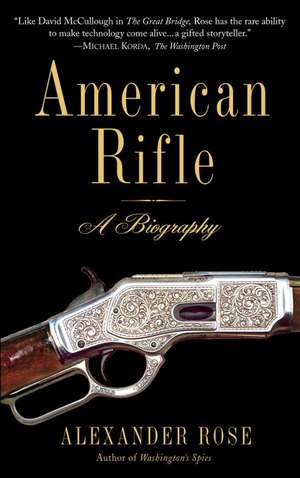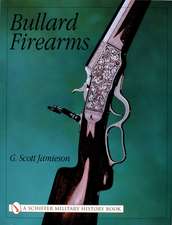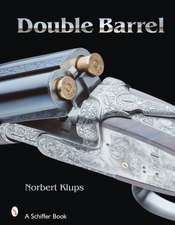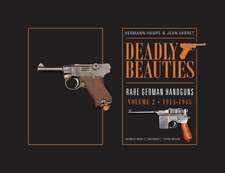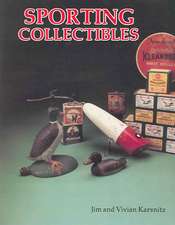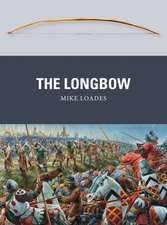American Rifle: A Biography
Autor Alexander Roseen Limba Engleză Paperback – 31 aug 2009
George Washington insisted that his portrait be painted with one. Daniel Boone created a legend with one. Abraham Lincoln shot them on the White House lawn. And Teddy Roosevelt had his specially customized.
In this first-of-its-kind book, historian Alexander Rose delivers a colorful, engrossing biography of an American icon: the rifle. Drawing on the words of foot soldiers, inventors, and presidents, based on extensive new research, and spanning from the Revolution to the present day, American Rifle is a balanced, wonderfully entertaining history of the rifle and its place in American culture.
Preț: 145.99 lei
Nou
Puncte Express: 219
Preț estimativ în valută:
27.94€ • 30.34$ • 23.47£
27.94€ • 30.34$ • 23.47£
Carte tipărită la comandă
Livrare economică 23 aprilie-07 mai
Preluare comenzi: 021 569.72.76
Specificații
ISBN-13: 9780553384383
ISBN-10: 0553384384
Pagini: 528
Ilustrații: B&W ILLUS T/O & 2 8P INSERTS
Dimensiuni: 153 x 229 x 29 mm
Greutate: 0.54 kg
Editura: DELTA
ISBN-10: 0553384384
Pagini: 528
Ilustrații: B&W ILLUS T/O & 2 8P INSERTS
Dimensiuni: 153 x 229 x 29 mm
Greutate: 0.54 kg
Editura: DELTA
Notă biografică
Born in the United States, Alexander Rose was raised in Australia and Britain. A military historian and former journalist, he is the author of Washington’s Spies: The Story of America’s First Spy Ring, and his writing has appeared in the New York Observer, the Washington Post, Studies in Intelligence, and many other publications.
Extras
Chapter One
The Mystery of Washington's Rifle
George Washington, never exactly a cheerful or chipper soul, was today even more glum than usual. It was May 21, 1772, and all day he had been posing for his portrait motionless, awkwardly dressed in an antique uniform originally tailored for a younger, slimmer man. The painter—an up-and-coming artist by the name of Charles Willson Peale—was certainly taking his time about it.
And then, at last, Washington was allowed to see the result. There he was, looking suspiciously more youthful (Peale knew how to flatter his subjects) than his forty years might suggest, but otherwise the likeness was most accurate. There he stood, Colonel George Washington of the defunct Virginia Regiment, officer, gentleman, loyal servant of His Majesty, and veteran of the French and Indian War.
Peale's portrait of Washington—the earliest authentic likeness of the man that is known to exist—is distinguished from hundreds of other pictures of eighteenth-century soldiers hanging in the world's museums in one remarkable respect. It's easy to overlook, but, subtly protruding from behind Washington's left shoulder, is the muzzle of an American rifle.
This particular arm had probably been commissioned two years before, in early 1770. In March of that year Washington was staying with his friend Robert Alexander, and according to his diary, they often "went out a hunting" foxes; but he one day rode to "George Town" (then a small place eight miles upstream from Alexandria, Virginia) to pick up "my rifle" from the gunsmith John Jost (or Yost) for £6 and 10 shillings. (An exact conversion to today's dollars is extremely difficult to determine, but $1,400 is a very rough approximation.) Gratifyingly, the cost of the firearm was partly offset by Washington's winning of £1 and 5 shillings from his host at cards, while its fineness can be gauged by the fact that during the Revolution Jost would make rifles for American troops invoiced at £4 and 15 shillings each—and this after prices had already soared owing to inflation. Washington may well have paid more than a 100 percent premium for the privilege of owning a custom-made Jost.
Few but Washington would have instructed their portraitists to add such a weapon. Rifles, at the time, were rarities among common soldiers and were carried by officers only in the field—the hunting field, that is, for the noble pursuit of shooting game, not the battlefield. Among civilians, many Americans weren't even sure what exactly a rifle was. As late as June 1775 John Adams mentioned to Abigail that he had recently heard about this "peculiar kind of musket, called a rifle" which had "grooves within the barrel, and carries a ball with great exactness to great distances."
All of which makes Washington's insistence on including one of these "peculiar" firearms in his portrait all the more mysterious. Indeed, a man who wished to use an object as an emblem of rank might have brandished it openly, but he didn't. The rifle is instead discreetly tucked away in the background, serving, it seems, as a reassuring symbol, for those in the know, that this individual, dressed in a uniform last donned two decades before, is one of them. So what was Washington telling his fellow Americans? The answer lies hidden somewhere amid the vast, remote American wilderness, an unconquered territory densely thicketed by forests, rumpled by towering mountain ranges, and watered by unbridgeable rivers. For newcomers to this land, it was a terrifying place such as had not existed in Europe since the dark and cold days of the Neanderthals. It was the frontier.
The great Spanish conquests did not hinge on firearms. Columbus brought with him just one for his infantry—a gun weighing about thirty pounds aptly named the "hand-cannon"—on his voyage to the New World in 1492. This type of weapon, which consisted of an inch-or-so-wide iron tube mounted on a broomstick-sized pole, could be lethal up to a few dozen yards, but its noise, smoke, and flash were undoubtedly its scariest qualities. Thirty years later Hernan Cortes brought down King Montezuma and his mighty Aztec empire with 110 sailors and 508 soldiers, of whom only twelve carried guns.
Owing to the unwieldiness of guns, as well as the impossibility of obtaining extra supplies for them, the conquistadors preferred to use simple, low-tech weaponry and sheer will to carry the day. In 2004 in Peru archaeologists excavated the remains of a man thought to be the earliest known gunshot victim in the Americas. He was lying in a mass grave with five hundred-odd other victims—Inca Indians who had rebelled against the Spaniards in 1536—with a bullet wound to the head from a ball fired from a hundred feet away. Since then, several other skeletons have been found with similar injuries. However, the vast majority of those killed exhibit signs not of gunshot trauma but of wounds caused by violent crushing (by horses' hooves), impalement by pikes, or hacking, smashing, and tearing by other iron weapons. The Amerindian empires were undone not by European technological superiority but by their own internal dissension, germs, their leaders' indecision, the Spaniards' employment of Indian allies disaffected from their overlords, and the foreigners' use of war dogs and horses to cow foes.
Firearms genuinely came into their own only in the early seventeenth century: on July 30, 1609, to be exact, when Samuel de Champlain, the French explorer and fur trader, accompanied his sixty Montagnais and Huron allies on a raid near the Ticonderoga against their mutual enemies, the Mohawks. Just two volleys from a couple of muskets put to flight a numerically superior force of two hundred. Admittedly, however, Champlain's shots had inflicted more damage to morale than to flesh and bone.
The Mohawks eventually recovered from their fear of the Europeans' thunder-making machines, but even then they and many other tribes were reluctant to dispense with their traditional weaponry. Being heavy, inaccurate, useless in the rain, instantly spottable at night, and based on iron and gunpowder (two elements requiring specialized production facilities), the early gun initially found few takers.
The increasing use of the serpentine, an idea borrowed from crossbows, began to change these attitudes. This was a freely pivoting, S-shaped metal arm attached to the breech—that part of the gun behind the barrel—that served simultaneously as a rudimentary trigger and as a clamp to hold the match, a lengthy wick that burned at an even rate. By suspending the match above the priming powder until the shooter pulled the trigger, the serpentine allowed the firer to hold the "matchlock" gun with both hands—unlike the old harquebus, which had to be steadied with one hand as the other manually applied the match to the powder. As a result, accuracy greatly improved, though the issue of long-glowing, slow-burning matches giving away one's position remained nettlesome.
With the arrival of the flintlock, which used flints to ignite sparks on demand, shooters could forever dispense with sputtering matches. While Europeans saw this new type of gun as merely a gentle evolutionary progression past the basic matchlock, Indians quickly realized that flintlocks comprised an entire replacement technology that rendered their bows and arrows obsolete. To them, the flintlock was a sudden, punctuated revolutionary leap forward.
At that point the Indian adoption of flintlock firearms became extraordinarily rapid. As early as 1628, wrote William Bradford, an early governor of Plymouth Colony, the moment the Wampanoags "saw the execution that a piece [musket] would do, and the benefit that might come by the same, they became mad (as it were) after them and would not stick to give any price." They reckoned "their bows and arrows but baubles in comparison to them." Exactly a century later the Indians used "nothing but firearms," remarked William Byrd, a Virginia lawyer who traveled the area widely. "Bows and arrows are grown into disuse, except only amongst their boys."
Purchasing firearms was one thing: as with most forms of technology (such as cars and computers), maintaining them in decent condition over the long term added considerably to their cost in time, effort, and cash. Needing not only spare parts to remain in working order, guns also required a constant supply of powder and ammunition. Neither the parts, nor the powder, nor the bullets, let alone skilled gunsmiths, were easy to come by.
The Indians were quick to learn how to make rudimentary repairs and basic lead ammunition. For parts, they cannibalized unsalvageable weapons. According to Bradford, they soon owned "moulds to make shot of all sorts, as musket bullets, pistol bullets, swan and goose shot, and of smaller shots," then moved on to forging "screw-plates to make screw-pins themselves when they want them." Given that settlers generally took their firearms to smiths if they were broken, the Indians' ability to take care of the bare essentials meant that they were soon "better fitted and furnished than the English themselves."
Still, performing a simple repair on a gun was a far cry from manufacturing one. Aware of the necessity of keeping certain forms of knowledge and technology out of Indian hands, in 1630 New England colonial governments forbade whites to teach any Indian how "to make or amend" firearms. A decade later gunsmiths were banned from repairing seriously damaged Indian-owned weapons; in reaction, Indians took up blacksmithing. In the 1650s, in a final effort at gun control, New Englanders outlawed the sale or distribution of key specialized parts, such as barrels and firelocks, that only experienced artisans could produce.
Not surprisingly, the talents of competent gunsmiths became highly prized—so much so that their skills could save their lives if captured in hostile territory. During Lewis and Clark's expedition to the Pacific, Le Borgne, a one-eyed Indian chief, threatened to massacre the Corps of Discovery but said he would make an exception for "the worker of iron and the mender of guns." During the Pontiac uprising of 1763, when Shawnee, Delaware, and Seneca warriors laid siege to Fort Pitt (now Pittsburgh), they demanded that English soldiers and settlers leave or be killed but that the gunsmiths must stay—and they promised them fair treatment.
At least New Englanders did not have to worry about the Indians making their own gunpowder, which was the product of a multistep, highly specialized chemical and industrial process. Gamely, if unsuccessfully, they tried alternative means of acquiring the gray powder more desired than glimmering gold. In 1637 Pequots kidnapped two young English girls and asked them, according to Edward Winslow, the lordly Plymouth governor, "whether they could make gunpowder. Which when they understood they could not do, their prize seemed nothing so precious a pearl as before." (Dutch traders later freed them.)
As early as 1639 Massachusetts attempted to establish its own powder mills, and three years later the colony's General Court ruled that every plantation and town must build its own saltpeter house. Gunpowder, said its elders, was "the instrumental means that all nations lay hold on for their preservation." Because natural deposits of saltpeter, the key ingredient of gunpowder (it provides the oxygen needed to burn the powder rapidly at high temperature), were unknown in New England, the colonists used a special shed to mix limestone, old mortar, and ashes with animal and vegetable refuse gathered from slaughterhouses and farms, which was then moistened with urine. That of a horse was most often used, but a heavy wine drinker's was much sought, for it was reputed to make the mightiest powder. After decomposing, the compound was leached with water and the crystallized saltpeter extracted. Note that this was a pretty rough-and-ready method for harvesting saltpeter (and would not have passed muster in the finer European armories), but it had to do.
Despite Massachusetts's best efforts, all its powder mills failed either financially or productively. Not until 1675, about thirty-five years after the colony's initial attempt, did a mill at Milton, on the Neponset River, at last succeed in making sufficient quantities of powder to supply the provincial troops and militias. In October 1676 Edward Randolph reported back to London that "the powder is as good and strong as the best English powder." Even so, until the Revolution gunpowder could be hard to come by in parts of America.
The great paradox of gunpowder was that although it was enormously difficult to make, it was also, owing to its lightness and its fluid shape, ridiculously simple to smuggle. A pound or two in a deerskin pouch was sufficient to make a long trip for an illegal transaction economically worthwhile. At the opposite end of the spectrum, musket balls were easy to make—all one needed was a flame, a cheap pair of tongs, and a spherical bullet mold—but the raw lead was so heavy that it was too burdensome to sell in bulk at a profit. The gunpowder shortage continued with ammunition self-rationing encouraged gun owners not to waste their shots. Aim carefully, fire once, was the rule. The habit died hard: in the future the thriftiness and marksmanship of American shooters would become renowned throughout Europe.
The government's efforts initially succeeded in reducing the number of new weapons and the amount of gunpowder available, but their effectiveness was slowly eroded by gunrunning during the Thirty Years' War (1618-48). North America became a proxy battlefield for the great powers of Europe. Native tribes who were allied to the English, or who were regarded as being useful irritants to the French, accordingly received shipments of guns, either as a reward for their loyalty or as a bribe to induce it. The English were by no means alone in this practice. At various times before the Revolution, they, the French, the Swedes, the Germans, and the Dutch denounced one another for trading in munitions while busily selling weapons to their own Indian allies.
Europeans expertly manipulated the Indian hunger for guns for profit and control. By the 1720s Indian dependence on European firearms was well established. No one dissented when Long Warrior observed to his fellow Cherokees that the warriors today "have all their goods of the English arms to defend themselves [without which] they could not go to war and that they'll always be ruled by them." For some colonists, nevertheless, the gun trade was an altruistic one. The British often claimed that by arming the native Americans with modern weaponry, they were raising the savage to civility. To that end the South Carolina governor James Glen reminded an audience of young Cherokees what life was like before his kind arrived: "Instead of the admirable firearms that you are now plentifully supplied with, your best arms [were] bad bows and wretched arrows headed with bills of birds and bones of fishes or at best with sharp stones . . . Your knives were split canes and your hatchets were of stone, so that you spent more days in felling a tree than you now do minutes."
Despite Glen's optimism, the trade was not always equally beneficial. From the Indians, the British needed only skins and pelts; from the British, the Indians wanted—in addition to weapons, powder, and parts—ironware, clothes, shoes, utensils, bric-a-brac, food, medicine, and liquor. Owing to this imbalance, if a particular tribe was not being cooperative, the British could easily threaten to switch suppliers; that same tribe, however, would have a hard time weaning itself from British goods if relations worsened. For dedicated officials the gun trade was key to maintaining imperial order and realizing peaceful stability on the frontier. "Trade governs these people," observed Colonel Charlesworth Glover in the late 1720s as he counseled against sending troops to beat down the Creeks. He was right. By the 1780s the Creeks were finished, undone by rampant consumerism and rum.
From the Hardcover edition.
The Mystery of Washington's Rifle
George Washington, never exactly a cheerful or chipper soul, was today even more glum than usual. It was May 21, 1772, and all day he had been posing for his portrait motionless, awkwardly dressed in an antique uniform originally tailored for a younger, slimmer man. The painter—an up-and-coming artist by the name of Charles Willson Peale—was certainly taking his time about it.
And then, at last, Washington was allowed to see the result. There he was, looking suspiciously more youthful (Peale knew how to flatter his subjects) than his forty years might suggest, but otherwise the likeness was most accurate. There he stood, Colonel George Washington of the defunct Virginia Regiment, officer, gentleman, loyal servant of His Majesty, and veteran of the French and Indian War.
Peale's portrait of Washington—the earliest authentic likeness of the man that is known to exist—is distinguished from hundreds of other pictures of eighteenth-century soldiers hanging in the world's museums in one remarkable respect. It's easy to overlook, but, subtly protruding from behind Washington's left shoulder, is the muzzle of an American rifle.
This particular arm had probably been commissioned two years before, in early 1770. In March of that year Washington was staying with his friend Robert Alexander, and according to his diary, they often "went out a hunting" foxes; but he one day rode to "George Town" (then a small place eight miles upstream from Alexandria, Virginia) to pick up "my rifle" from the gunsmith John Jost (or Yost) for £6 and 10 shillings. (An exact conversion to today's dollars is extremely difficult to determine, but $1,400 is a very rough approximation.) Gratifyingly, the cost of the firearm was partly offset by Washington's winning of £1 and 5 shillings from his host at cards, while its fineness can be gauged by the fact that during the Revolution Jost would make rifles for American troops invoiced at £4 and 15 shillings each—and this after prices had already soared owing to inflation. Washington may well have paid more than a 100 percent premium for the privilege of owning a custom-made Jost.
Few but Washington would have instructed their portraitists to add such a weapon. Rifles, at the time, were rarities among common soldiers and were carried by officers only in the field—the hunting field, that is, for the noble pursuit of shooting game, not the battlefield. Among civilians, many Americans weren't even sure what exactly a rifle was. As late as June 1775 John Adams mentioned to Abigail that he had recently heard about this "peculiar kind of musket, called a rifle" which had "grooves within the barrel, and carries a ball with great exactness to great distances."
All of which makes Washington's insistence on including one of these "peculiar" firearms in his portrait all the more mysterious. Indeed, a man who wished to use an object as an emblem of rank might have brandished it openly, but he didn't. The rifle is instead discreetly tucked away in the background, serving, it seems, as a reassuring symbol, for those in the know, that this individual, dressed in a uniform last donned two decades before, is one of them. So what was Washington telling his fellow Americans? The answer lies hidden somewhere amid the vast, remote American wilderness, an unconquered territory densely thicketed by forests, rumpled by towering mountain ranges, and watered by unbridgeable rivers. For newcomers to this land, it was a terrifying place such as had not existed in Europe since the dark and cold days of the Neanderthals. It was the frontier.
The great Spanish conquests did not hinge on firearms. Columbus brought with him just one for his infantry—a gun weighing about thirty pounds aptly named the "hand-cannon"—on his voyage to the New World in 1492. This type of weapon, which consisted of an inch-or-so-wide iron tube mounted on a broomstick-sized pole, could be lethal up to a few dozen yards, but its noise, smoke, and flash were undoubtedly its scariest qualities. Thirty years later Hernan Cortes brought down King Montezuma and his mighty Aztec empire with 110 sailors and 508 soldiers, of whom only twelve carried guns.
Owing to the unwieldiness of guns, as well as the impossibility of obtaining extra supplies for them, the conquistadors preferred to use simple, low-tech weaponry and sheer will to carry the day. In 2004 in Peru archaeologists excavated the remains of a man thought to be the earliest known gunshot victim in the Americas. He was lying in a mass grave with five hundred-odd other victims—Inca Indians who had rebelled against the Spaniards in 1536—with a bullet wound to the head from a ball fired from a hundred feet away. Since then, several other skeletons have been found with similar injuries. However, the vast majority of those killed exhibit signs not of gunshot trauma but of wounds caused by violent crushing (by horses' hooves), impalement by pikes, or hacking, smashing, and tearing by other iron weapons. The Amerindian empires were undone not by European technological superiority but by their own internal dissension, germs, their leaders' indecision, the Spaniards' employment of Indian allies disaffected from their overlords, and the foreigners' use of war dogs and horses to cow foes.
Firearms genuinely came into their own only in the early seventeenth century: on July 30, 1609, to be exact, when Samuel de Champlain, the French explorer and fur trader, accompanied his sixty Montagnais and Huron allies on a raid near the Ticonderoga against their mutual enemies, the Mohawks. Just two volleys from a couple of muskets put to flight a numerically superior force of two hundred. Admittedly, however, Champlain's shots had inflicted more damage to morale than to flesh and bone.
The Mohawks eventually recovered from their fear of the Europeans' thunder-making machines, but even then they and many other tribes were reluctant to dispense with their traditional weaponry. Being heavy, inaccurate, useless in the rain, instantly spottable at night, and based on iron and gunpowder (two elements requiring specialized production facilities), the early gun initially found few takers.
The increasing use of the serpentine, an idea borrowed from crossbows, began to change these attitudes. This was a freely pivoting, S-shaped metal arm attached to the breech—that part of the gun behind the barrel—that served simultaneously as a rudimentary trigger and as a clamp to hold the match, a lengthy wick that burned at an even rate. By suspending the match above the priming powder until the shooter pulled the trigger, the serpentine allowed the firer to hold the "matchlock" gun with both hands—unlike the old harquebus, which had to be steadied with one hand as the other manually applied the match to the powder. As a result, accuracy greatly improved, though the issue of long-glowing, slow-burning matches giving away one's position remained nettlesome.
With the arrival of the flintlock, which used flints to ignite sparks on demand, shooters could forever dispense with sputtering matches. While Europeans saw this new type of gun as merely a gentle evolutionary progression past the basic matchlock, Indians quickly realized that flintlocks comprised an entire replacement technology that rendered their bows and arrows obsolete. To them, the flintlock was a sudden, punctuated revolutionary leap forward.
At that point the Indian adoption of flintlock firearms became extraordinarily rapid. As early as 1628, wrote William Bradford, an early governor of Plymouth Colony, the moment the Wampanoags "saw the execution that a piece [musket] would do, and the benefit that might come by the same, they became mad (as it were) after them and would not stick to give any price." They reckoned "their bows and arrows but baubles in comparison to them." Exactly a century later the Indians used "nothing but firearms," remarked William Byrd, a Virginia lawyer who traveled the area widely. "Bows and arrows are grown into disuse, except only amongst their boys."
Purchasing firearms was one thing: as with most forms of technology (such as cars and computers), maintaining them in decent condition over the long term added considerably to their cost in time, effort, and cash. Needing not only spare parts to remain in working order, guns also required a constant supply of powder and ammunition. Neither the parts, nor the powder, nor the bullets, let alone skilled gunsmiths, were easy to come by.
The Indians were quick to learn how to make rudimentary repairs and basic lead ammunition. For parts, they cannibalized unsalvageable weapons. According to Bradford, they soon owned "moulds to make shot of all sorts, as musket bullets, pistol bullets, swan and goose shot, and of smaller shots," then moved on to forging "screw-plates to make screw-pins themselves when they want them." Given that settlers generally took their firearms to smiths if they were broken, the Indians' ability to take care of the bare essentials meant that they were soon "better fitted and furnished than the English themselves."
Still, performing a simple repair on a gun was a far cry from manufacturing one. Aware of the necessity of keeping certain forms of knowledge and technology out of Indian hands, in 1630 New England colonial governments forbade whites to teach any Indian how "to make or amend" firearms. A decade later gunsmiths were banned from repairing seriously damaged Indian-owned weapons; in reaction, Indians took up blacksmithing. In the 1650s, in a final effort at gun control, New Englanders outlawed the sale or distribution of key specialized parts, such as barrels and firelocks, that only experienced artisans could produce.
Not surprisingly, the talents of competent gunsmiths became highly prized—so much so that their skills could save their lives if captured in hostile territory. During Lewis and Clark's expedition to the Pacific, Le Borgne, a one-eyed Indian chief, threatened to massacre the Corps of Discovery but said he would make an exception for "the worker of iron and the mender of guns." During the Pontiac uprising of 1763, when Shawnee, Delaware, and Seneca warriors laid siege to Fort Pitt (now Pittsburgh), they demanded that English soldiers and settlers leave or be killed but that the gunsmiths must stay—and they promised them fair treatment.
At least New Englanders did not have to worry about the Indians making their own gunpowder, which was the product of a multistep, highly specialized chemical and industrial process. Gamely, if unsuccessfully, they tried alternative means of acquiring the gray powder more desired than glimmering gold. In 1637 Pequots kidnapped two young English girls and asked them, according to Edward Winslow, the lordly Plymouth governor, "whether they could make gunpowder. Which when they understood they could not do, their prize seemed nothing so precious a pearl as before." (Dutch traders later freed them.)
As early as 1639 Massachusetts attempted to establish its own powder mills, and three years later the colony's General Court ruled that every plantation and town must build its own saltpeter house. Gunpowder, said its elders, was "the instrumental means that all nations lay hold on for their preservation." Because natural deposits of saltpeter, the key ingredient of gunpowder (it provides the oxygen needed to burn the powder rapidly at high temperature), were unknown in New England, the colonists used a special shed to mix limestone, old mortar, and ashes with animal and vegetable refuse gathered from slaughterhouses and farms, which was then moistened with urine. That of a horse was most often used, but a heavy wine drinker's was much sought, for it was reputed to make the mightiest powder. After decomposing, the compound was leached with water and the crystallized saltpeter extracted. Note that this was a pretty rough-and-ready method for harvesting saltpeter (and would not have passed muster in the finer European armories), but it had to do.
Despite Massachusetts's best efforts, all its powder mills failed either financially or productively. Not until 1675, about thirty-five years after the colony's initial attempt, did a mill at Milton, on the Neponset River, at last succeed in making sufficient quantities of powder to supply the provincial troops and militias. In October 1676 Edward Randolph reported back to London that "the powder is as good and strong as the best English powder." Even so, until the Revolution gunpowder could be hard to come by in parts of America.
The great paradox of gunpowder was that although it was enormously difficult to make, it was also, owing to its lightness and its fluid shape, ridiculously simple to smuggle. A pound or two in a deerskin pouch was sufficient to make a long trip for an illegal transaction economically worthwhile. At the opposite end of the spectrum, musket balls were easy to make—all one needed was a flame, a cheap pair of tongs, and a spherical bullet mold—but the raw lead was so heavy that it was too burdensome to sell in bulk at a profit. The gunpowder shortage continued with ammunition self-rationing encouraged gun owners not to waste their shots. Aim carefully, fire once, was the rule. The habit died hard: in the future the thriftiness and marksmanship of American shooters would become renowned throughout Europe.
The government's efforts initially succeeded in reducing the number of new weapons and the amount of gunpowder available, but their effectiveness was slowly eroded by gunrunning during the Thirty Years' War (1618-48). North America became a proxy battlefield for the great powers of Europe. Native tribes who were allied to the English, or who were regarded as being useful irritants to the French, accordingly received shipments of guns, either as a reward for their loyalty or as a bribe to induce it. The English were by no means alone in this practice. At various times before the Revolution, they, the French, the Swedes, the Germans, and the Dutch denounced one another for trading in munitions while busily selling weapons to their own Indian allies.
Europeans expertly manipulated the Indian hunger for guns for profit and control. By the 1720s Indian dependence on European firearms was well established. No one dissented when Long Warrior observed to his fellow Cherokees that the warriors today "have all their goods of the English arms to defend themselves [without which] they could not go to war and that they'll always be ruled by them." For some colonists, nevertheless, the gun trade was an altruistic one. The British often claimed that by arming the native Americans with modern weaponry, they were raising the savage to civility. To that end the South Carolina governor James Glen reminded an audience of young Cherokees what life was like before his kind arrived: "Instead of the admirable firearms that you are now plentifully supplied with, your best arms [were] bad bows and wretched arrows headed with bills of birds and bones of fishes or at best with sharp stones . . . Your knives were split canes and your hatchets were of stone, so that you spent more days in felling a tree than you now do minutes."
Despite Glen's optimism, the trade was not always equally beneficial. From the Indians, the British needed only skins and pelts; from the British, the Indians wanted—in addition to weapons, powder, and parts—ironware, clothes, shoes, utensils, bric-a-brac, food, medicine, and liquor. Owing to this imbalance, if a particular tribe was not being cooperative, the British could easily threaten to switch suppliers; that same tribe, however, would have a hard time weaning itself from British goods if relations worsened. For dedicated officials the gun trade was key to maintaining imperial order and realizing peaceful stability on the frontier. "Trade governs these people," observed Colonel Charlesworth Glover in the late 1720s as he counseled against sending troops to beat down the Creeks. He was right. By the 1780s the Creeks were finished, undone by rampant consumerism and rum.
From the Hardcover edition.
Recenzii
“Marvelous…. Like David McCullough in The Great Bridge, Rose has the rare ability to make technology come alive even for the non-technology-minded. He is not only a good historian but also a gifted storyteller.”—Michael Korda, Washington Post
“Fascinating…. The history of the U.S. is mirrored in the history of one of it technological achievements…. Loaded with detail, full of lively characters and an abundant spirit of invention. The history of the rifle is also the history of mass production, of American politics, of the legal system, and of war itself.”—Booklist
“Entertaining…. Loaded with facts…. Drawing on numerous primary sources, from letters and journals of ordinary soldiers to the writings of inventors such as Samuel Colt, Rose traces the rise of the rifle from its original use as a hunting tool and a means of defense and protection to its eventual use as an offensive weapon in wars of conquest.”—Publishers Weekly
“One of the most interesting nonfiction books of the year…. packed with fascinating anecdotes … and keen insights into the nexus of civilian politics, business, and the military.”—National Review
“Good reading for those on either side of the gun-control debate….A fascinating story replete with missed opportunities, skulduggery, entrenched dogma and internecine battles.”—Sunday Oregonian
“Ingenious and satisfying…. Provides surprising insight into the country’s history.”–Kirkus Reviews, starred review
“Definitive … full of lost historical fact and intriguing anecdotes.”–Sacramento Bee
"Irresistible history…American Rifle, a biography of a revolutionary idea, is ingeniously conceived, deftly written and thoroughly engrossing."—Dallas Morning News
From the Hardcover edition.
“Fascinating…. The history of the U.S. is mirrored in the history of one of it technological achievements…. Loaded with detail, full of lively characters and an abundant spirit of invention. The history of the rifle is also the history of mass production, of American politics, of the legal system, and of war itself.”—Booklist
“Entertaining…. Loaded with facts…. Drawing on numerous primary sources, from letters and journals of ordinary soldiers to the writings of inventors such as Samuel Colt, Rose traces the rise of the rifle from its original use as a hunting tool and a means of defense and protection to its eventual use as an offensive weapon in wars of conquest.”—Publishers Weekly
“One of the most interesting nonfiction books of the year…. packed with fascinating anecdotes … and keen insights into the nexus of civilian politics, business, and the military.”—National Review
“Good reading for those on either side of the gun-control debate….A fascinating story replete with missed opportunities, skulduggery, entrenched dogma and internecine battles.”—Sunday Oregonian
“Ingenious and satisfying…. Provides surprising insight into the country’s history.”–Kirkus Reviews, starred review
“Definitive … full of lost historical fact and intriguing anecdotes.”–Sacramento Bee
"Irresistible history…American Rifle, a biography of a revolutionary idea, is ingeniously conceived, deftly written and thoroughly engrossing."—Dallas Morning News
From the Hardcover edition.
